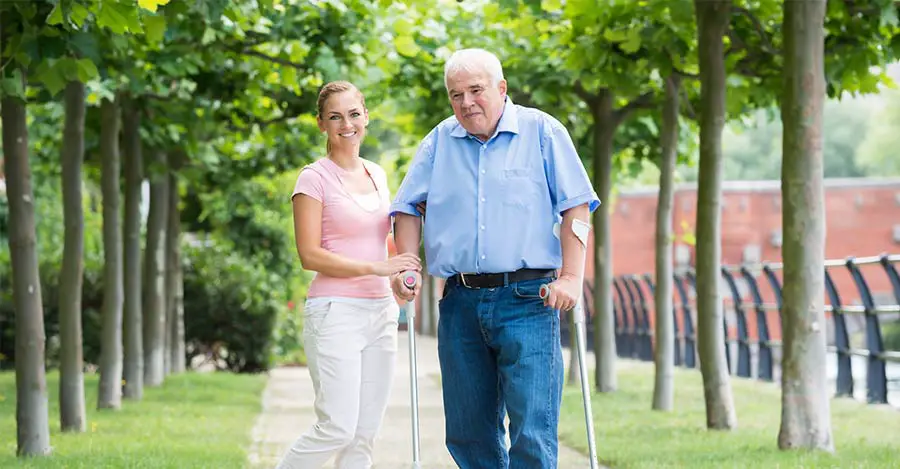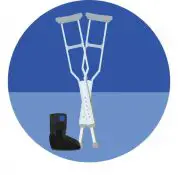10 Tips For Physical Activity While On Crutches Or While Living With A Disability
- Last Update:
Regular exercise is good for everyone. Yet those who are injured or living with a disability can find it difficult to start to exercise again. Additionally, because of the COVID-19 pandemic, more people using crutches are not going out often. They are also exercising less.
Fortunately, those using crutches because of an injury or disability can exercise if they follow the tips in this article. We have taken time to thoroughly research the topic extensively and have come across the ten tips you need to know.
We will also discuss the various benefits of physical activity so that those using crutches can be motivated to start exercising.
The Benefit Of Physical Activity (Exercise) For Those On Crutches Because of An Injury or Disability
Were you aware that, according to numerous research studies, the benefits of physical activity go beyond physical well-being? Best of all, anyone and everyone can experience the health benefits associated with exercising. This is regardless of disability, age, ethnicity, size, gender, or injury (within reason).
Below we have briefly discussed how physical activity can benefit those using crutches. We have analyzed three distinctive areas and will summarize how a person benefits physically, mentally, and emotionally from exercise.
Physical

Do you know that people with disabilities are believed to be 57% more likely to be obese than those who don’t have a disability? Additionally, it’s estimated that less than half of American adults who have difficulties climbing stairs or walking engage in aerobic physical activity.
It’s a common misconception that those who are disabled and using crutches are unable to exercise. Yet, depending on the disability and the level of pain a person experiences, exercising is not only possible but beneficial.
There are many physical benefits that those using crutches because of an injury or disability could look forward to. For example, being physically active can help manage weight loss and improve brain health and cognitive function.
It can also reduce the risk of many diseases like heart disease and diabetes. Additionally, exercising could improve your ability to complete daily activities. This is especially beneficial to those using crutches.
Mental
Besides physical benefits, many mental benefits are associated with being physically active while using crutches. For example, regular exercise has been proven to positively impact anxiety, PTSD, depression, and anxiety.
Additionally, you don’t need to become a fitness fanatic to benefit mentally from exercise. Numerous research studies have indicated that modest amounts of exercise are usually enough to make a real difference in a person’s life.
Emotional
Many people often disregard emotional health, but it’s crucial to your overall health and mental well-being. This is because emotionally healthy people are far more in control of their behaviors, thoughts, and feelings. If you’re emotionally healthy, you will better cope with life’s difficulties and keep problems in perspective.
Interestingly, one of the best ways to be emotionally healthy, especially if you’re using crutches because of injury or a disability, is to exercise. Those who exercise are more emotionally stable because they have a better sense of well-being.
Exercise also helps others be more emotionally happy because it promotes energy and helps people sleep better at night. Exercise also helps people feel more confident, positive and relaxed, promoting emotional well-being.
10 Tips On How To Restart Physical Activity Again On Crutches While Injured Or Living With A Disability
Now that you know more about the benefits of physical activity and how it can help a person physically, mentally, and emotionally, it’s time to discuss tips.
Below you will find ten tips on restarting your physical activity journey if you’re injured or living with a disability and have to use crutches. These tips can help you take control of your health and help place you on a healthier path towards better overall happiness.
Before Starting To Exercise, Consult With Your Doctor

The first thing you need to do before you start exercising is to consult with your doctor. This way, you can find out what you can and cannot do. In most instances, adults with chronic health conditions and disabilities can take part in routine exercise. As long as your doctor, personal trainer, or physical therapist states that the fitness activities are fine, you can do them.
If your doctor says exercising is okay, you should aim for at least two and a half hours of aerobic physical activity weekly. This timeframe is the same whether you have a disability or not.
Start Slowly And Gradually Increase Your Pace
It might be tempting to start exercising at maximum capacity, but this could quickly lead to demotivation, burnout, and injury. You could also become incredibly frustrated if you try to complete exercises that you’re unable to do.
Usually, those using crutches should start exercising slowly and gradually so as not to lose interest in getting healthy. This will ensure you exercise at a safe level that’s per your injury or disability. Once you have built up the stamina and can try and up your pace, you can do so.
Don’t Overestimate Your Abilities

Unfortunately, many people on crutches often overestimate their abilities. This is because using crutches can sometimes mask the pain. Or make someone believe that they are not as injured as they believe. That’s why, as we said above, it’s best to take it easy. There’s nothing wrong with going at your own pace and being cautious.
If you feel uncomfortable, you must stop immediately and assess what is wrong. Doing this will ensure you don’t make the same exercise mistake again, lessening your chances of becoming injured.
Break Down Exercise Routines Into Bite-Sized Chunks
When faced with a lengthy exercise routine, it’s easy to feel dismayed and demotivated. After all, the last thing you want to do is struggle with a complex exercise set while trying to be cautious of your limits.
That’s why one of the best things you can do is break down your exercise routines into bite-sized chunks. For example, you can participate in yoga for 25 minutes every day instead of 50 minutes every day. Shorter exercise routines will be easier to complete and leave you feeling like you achieved your fitness goals.
Pick An Activity You Enjoy
If you dread your chosen fitness activity, you will struggle to exercise while on crutches. The best thing to do is pick an activity you know you will enjoy or feel will be easier on your injury or disability. For example, if you don’t like field activities while on crutches, you can choose to take up swimming.
See below a few of the best activities those on crutches should consider.
Aquatic therapy
Horseback riding
Hiking
Hand crank bicycling
Brisk walking
Exercise With Friends

When using crutches because of an injury or disability, it’s hard to exercise on your own and can be unsafe. That’s why it’s an excellent idea to exercise with friends. Not only will this be motivational, but you will also have peace of mind knowing that you have people exercising with you who can help you if necessary.
Yet, be careful not to try and match their fitness performance even if it is tempting. Learn your limits and teach your friends how to encourage you and be supportive of you while you exercise.
Warm Up, Stretch, And Cool Down
While exercising on crutches, there are three things you need to remember to do. That is always warming up, stretching and engaging in a cool down.
Before you start exercising, complete a series of warm-up activities. It’s also a great idea to stretch your muscles. Doing this will lessen chances of becoming injured while exercising on crutches.
Additionally, engaging in cool-down exercises will help lessen muscle stiffness. This can also help prevent injury.
Don’t Forget To Eat And Drink After Exercising

It’s uber easy to become so focused on achieving fitness goals that you forget to eat and drink. This is bad for two reasons. Firstly forgetting to eat before an exercise can mean you don’t have the energy you need to exercise properly. It can also make you incredibly dizzy or light-headed, leading to injury, especially if you use crutches.
Secondly, not eating after exercising can also affect your energy levels and mood. If you feel unhappy because you’re hungry, you’re likely not to want to exercise the next day again. Additionally, not eating before or after exercising can lead to unhealthy eating habits. This could contribute to unhealthy weight gain or weight loss. This can then affect how well you heal or cope with your disability.
Have A Positive Mindset
If you don’t have a positive mindset, you will struggle to exercise regardless of whether you use crutches. Half of the battle of exercising is to ensure you have the right mindset. That’s why if you believe you can exercise and commit to a routine, you will likely find exercising easier.
Of course, having a positive mindset can only go so far. How much you can exercise depends on the extent of your injuries or disability.
Final Word
It’s clear that exercising while on crutches because of an injury or disability is possible if you follow the ten simple tips outlined in this article. Each of these tips is easy to follow and will help you achieve your fitness goals.
Additionally, you now also know why exercising is so beneficial. The more you exercise safely, the more your mental, emotional, and physical health will improve.
